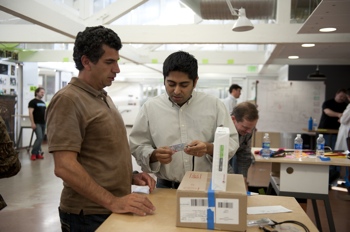
“Today our challenge as a group is to redesign the experience of giving a gift,” says Utley, director of executive education. Some of the participants look amused when they hear this – this is probably not the big hairy audacious goal they thought they would have to tackle. Utley lays down the ground rules. Everyone has to work in pairs and design something for the other person. The idea is simple: the design has to be “human-centric” and not “me-centric.”
They begin by giving everyone a limited number of minutes to discuss the last time each gave someone a gift. What worked? What didn’t? And how did the other person react to the present?
Clearly, not everyone is comfortable discussing what is essentially personal. Klebahn and Utley sense the unease as they walk around the room. “You may feel uncomfortable,” booms Kiebahn’s voice again. “If you want to be innovative, it will get uncomfortable.” Suddenly, he reaches out and strikes a gong in the front of the room. Time’s up for the first part of this exercise.
Part two, again a three-to-four minute exercise, aims to dig deeper and move beyond the tactical and logistical into emotional territory. As Utley puts it, “The goal in the next three to four minutes is to get the user to cry.” Everyone in the room bursts out laughing, but they quickly get to work. “If you find yourself straying off the gift-giving track, that’s alright. You are not wedded to the problem we gave you,” says Utley.
Several iterations later, Utley and Klebahn have pushed the participants to think beyond the obvious. Most have ventured into “emotional territory” going beyond the original idea of gift giving —“he has a tough relationship with his mother.” Minutes later the participants scramble around the room looking for material to build the prototype they have designed for their partner. Time is running out and they seem to be under pressure. One man with salt-and-pepper hair runs around blowing a balloon. A lady is hurriedly attaching bright red and pink pipe cleaners to two balls of aluminium foil, making what appears to be an aluminium snowman.
The gong sounds again. Time’s up. Everyone puts quick finishing touches on their prototypes so that they look complete – a pipe cleaner here, a Popsicle stick there, a quick reinforcement with duct tape. This exercise has led to some odd and peculiar prototypes.
The point of the exercise was to be able to get to needs that are dormant. “After all, in the first half of the exercise, there was no problem to work on,” says Utley, explaining how the whole process of thinking, probing and rapidly iterating helps to push the boundaries of innovation. In the debriefing session, participants talk about how they plan to trigger creativity in their organizations: “It’s OK to be foolish,” says one. “I’ll change the environment – I’ll have balloons in the room,” says another. “My next meeting will have no PowerPoints,” vows yet another participant. “I will be less critical and not insist on the right answer the first time,” says an exec. “I will ask everyone to sketch instead of talk,” says another.
While the design thinking exercise was about how to trigger creativity and innovation, another session led by O’Reilly focuses on leading cultural change. This session takes off from where the design thinking exercise left and connects it to the importance of organizational culture. “Once you understand how norms are created, the levers of managing culture will be clear,” he adds, explaining how culture can be changed even in large, established organizations. The takeaway: “People are walking into your elevator. You as a leader need to decide what the elevator looks like.”
O’Reilly’s session doesn’t mark the end of the day – not quite yet. The participants now work in their peer groups trying to solve the business challenge of one of the group members. The root cause analysis is due at 6 p.m. And tomorrow’s another day.





Questions about this article? Email us or leave a comment below.